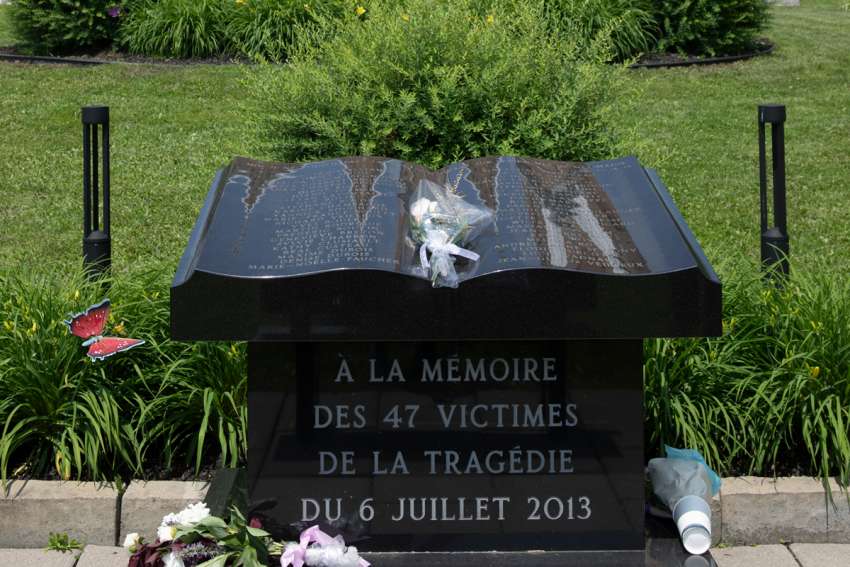Evisceration of the once vibrant Catholic culture of Québec has become a truism. Yet the role Sainte-Agnes Catholic Church has played in the small town of Lac-Mégantic since the 2013 train derailment and explosion that took 47 lives and destroyed the town centre stands as a contradiction to the ubiquitous narrative of spiritual decline.
It began with then pastor, Fr. Steve Lemay, only five years ordained, recognizing the devasted people of Lac-Mégantic needed access to the church. St. Agnes is mere steps away from the site of the fire. In the early days, it was placed in the no-go, or red zone.
According to Fr. Garrick Huang, current parochial administrator of St. Agnes, Lemay contacted the authorities to say, “You need to take the church out of the red zone because we need to be open 24-hours a day for the next few weeks to receive all of the bereavement and grief.”
Town officials listened, the church opened and the people came. Tens of thousands of votive candles were lit and placed on the steps leading up to the imposing brick building. Three weeks to the day after the July 6 disaster, 1,000 people attended a memorial Mass celebrated by Sherbrooke Archbishop Luc Cyr. The overflow crowd watched on a big screen set up outside the church.
Ten years have come and gone. To suitably mark the anniversary of one of the deadliest rail disasters in Canadian history, Huang and his pastoral team spent months planning three events stretched over a two-day period of reflection and prayer.
Lac-Mégantic mayor Julie Morin told media, “The church, after the tragedy, was very important. It quickly became a place of reference. So, the church is really at the heart of the commemoration.”
Beginning with a three-hour concert in the church on the evening of July 5, progressing to a silent march that began from the steps of the church in the early hours of July 6, and ending with Commemoration Mass on the same day, St. Agnes reprised a role it has played many times since 2013, as host to the bereaved, earnest well-wishers, eager journalists and politicians.
At the three events, family and friends of the deceased, parishioners, municipal leaders and clergy all had a place. At the concert, Richard Custeau, brother of victim Réal Custeau, played his guitar and sang. Former mayor Colette Roy-Laroche recited “Les Mains,” a poem she had composed for the fifth anniversary.
At the Commemoration Mass, the two mayors, municipal leaders from neighbouring towns, as well as the four priests who had pastored the church through the 10 years since the disaster were present. Lemay preached to those same people, reflecting on the chosen theme of the anniversary, “La Voie du Coeur,” or “The Way of the Heart,” with the word “voie” creating a pun on the word “voix” so the way of the heart was also the voice of the heart.
Parishioner Pierrette Turgeon Blanchet, “the grandmother” who read aloud the name of each victim at the first Memorial Mass, organized the nighttime march. The silent walk that wound through the town began at 1:14 a.m., the exact time the derailment and fires erupted. Leading the march were Huang, Morin and Roy-Laroche.
Huang said the two mayors instructed him, “You better say something, because people do not know what to do and they have come here, to your place.”
“At the end, I just thanked everybody and told them to make the city their own,” said Huang. “A lot of people said, ‘Our city was destroyed. What is left of it? It is not the same.’ I said, well, true, but now you have to make it your own.”
Huang also made an announcement that night: “Keep this as a good memory, because we are not going to do this again for a while.”
This reflects the sentiment of his pastoral team who told him, “We are doing our last celebration. We are turning the page.”
There is a certain weariness amongst the people of Lac-Mégantic. The channels of grief are now as well established as the path beaten by successive politicians and journalists between the two political centres of Quebec City and Ottawa and the steps of St. Agnes Church.
“It is difficult having so many reporters here and having so much attention” said Nathalie Leduc, a choir member. “We are grateful, of course, as we do not feel so alone, but it also brings it all up again.”
Two politicians who attended the Commemoration Mass, Prime Minister Justin Trudeau and Quebec Premier Francois Legault, had also attended the first Memorial Mass. Ten years ago, though, they were both members of the Opposition and sat several pews back from the first row they occupied this year.
This time round, the media scrum questioned the men about the long-promised rail bypass.
Trudeau told the media, “I made myself and the community a commitment that we would end the trains coming through this community .... We’re hoping to start construction this fall.”
The subject of the bypass and the expropriation of 40 properties by the federal government, as well as the environmental impact, has brought considerable division to the people of the six neighbouring parishes for which Huang is responsible.
In this matter, Huang has said that his role is to remain neutral. Ultimately, the most important place the church holds in Lac-Mégantic is “in the hearts and minds of the people.”


